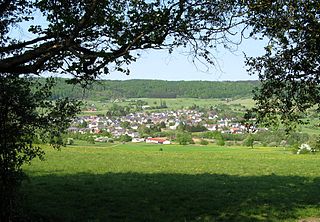
The Westerwald is a low mountain range on the right bank of the river Rhine in the German federal states of Rhineland-Palatinate, Hesse and North Rhine-Westphalia. It is a part of the Rhenish Massif. Its highest elevation, at 657 m above sea level, is the Fuchskaute in the High Westerwald.
Lahn-Dill is a Kreis (district) in the west of Hesse, Germany. Neighboring districts are Siegen-Wittgenstein, Marburg-Biedenkopf, Gießen, Wetteraukreis, Hochtaunuskreis, Limburg-Weilburg, Westerwaldkreis.
Limburg-Weilburg is a Kreis (district) in the west of Hesse, Germany. Neighboring districts are Lahn-Dill, Hochtaunuskreis, Rheingau-Taunus, Rhein-Lahn, Westerwaldkreis.

The Lahn is a 245.6-kilometre-long (152.6 mi), right tributary of the Rhine in Germany. Its course passes through the federal states of North Rhine-Westphalia (23.0 km), Hesse (165.6 km), and Rhineland-Palatinate (57.0 km).

Dillenburg, officially Oranienstadt Dillenburg, is a town in Hesse's Gießen region in Germany. The town was formerly the seat of the old Dillkreis district, which is now part of the Lahn-Dill-Kreis.

Nassau is a town located in the German state of Rhineland-Palatinate. It lies on the lower course of the Lahn River, on the mouth of the Mühlbach, between Limburg an der Lahn and the spa town of Bad Ems, and is located in the Nassau Nature Park, surrounded by the Westerwald to the north and the Taunus to the south. The town is on the German-Dutch holiday road, the Orange Route. As of 2021, it had a population of 4,592.

Leun is a small town in the Lahn-Dill-Kreis in Hesse, Germany.

Solms is a town west of Wetzlar in the Lahn-Dill-Kreis, Hessen, Germany with around 13,500 inhabitants. In the constituent community of Burgsolms once stood the ancestral castle of the Counts and Princes of Solms.

Aßlar is a town near Wetzlar in the Lahn-Dill-Kreis in Hesse, Germany.

Braunfels is a town in the Lahn-Dill-Kreis in Hesse, Germany. It is located on the German Timber-Frame Road.

Greifenstein is a municipality in the Lahn-Dill-Kreis in Hesse, Germany. Its administrative seat is Beilstein. Greifenstein covers 67.43 km2 on the eastern slope of the Westerwald range. It was named for the castle of the same name in the constituent community of the same name. Greifenstein is the site of the German Bell Museum, which holds about fifty bells that show the historical development of bell pouring and manufacture.

Sinn is a municipality in Middle Hesse, Germany, in the Lahn-Dill-Kreis.
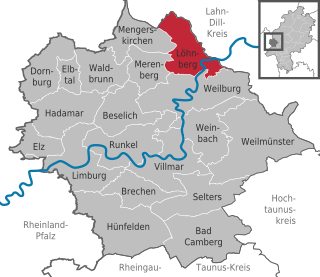
Löhnberg is a municipality north of Weilburg in Limburg-Weilburg district in Hesse, Germany.
John, Count of Nassau-Dillenburg was the third son of Count Otto I of Nassau and his wife Agnes, daughter of Count Emich IV of Leiningen-Landeck. John was a first cousin of King Adolf of the Romans.
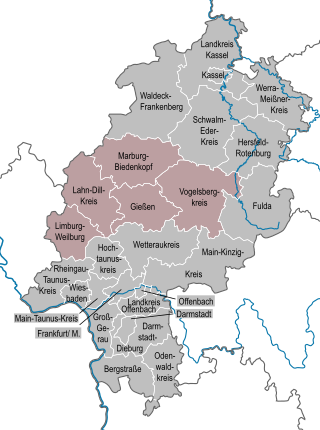
The region of Middle Hesse is one of three planning regions in the German state of Hesse, alongside North and South Hesse. Its territory is identical with that of the administrative province of Gießen and covers the counties of Limburg-Weilburg, Lahn-Dill-Kreis, Gießen, Marburg-Biedenkopf and Vogelsbergkreis. The Middle Hesse Regional Assembly, which decides on the regional plan, currently consists of 31 members chosen by the five counties and the three towns with special status: Gießen, Marburg and Wetzlar. The regional assembly has tasked the governing president (Regierungspräsident) with delivering regional management. The Mid-Hesse Regional Management Association was founded on 22 January 2003.
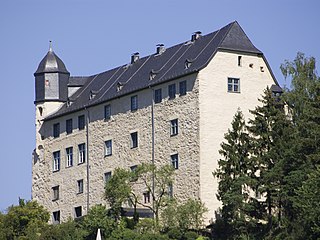
Schadeck Castle is a counter-castle which was built in opposition to the nearby Runkel Castle. It stands above the River Lahn in the eponymous parish in the county of Limburg-Weilburg in the German state of Hesse.
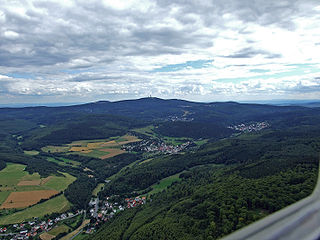
The Taunus Nature Park is a nature park in Central Germany with an area of 134,775 hectares (1347.75 km2) in the Central Upland range of the Taunus. It is one of two Hessian nature parks in the Taunus and the second largest nature park in Hesse.

Lichtenstein Castle is a levelled spur castle on the hill of Burgberg Lichtenstein, 315 m above sea level (NN), near the Greifenstein village of Holzhausen on the old military High Road, that ran from Frankfurt via Wetzlar to Cologne. The castle site is situated to the north of, and above, the Ulmbach Reservoir in the Hessian county of Lahn-Dill-Kreis.
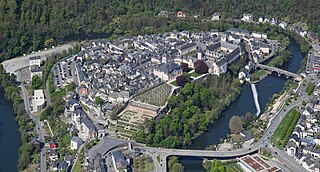
Schloss Weilburg is a Baroque schloss in Weilburg, Hesse, Germany. It is located on a spur above the river Lahn and occupies about half of the area of the Old Town of Weilburg. It contains the Hochschloss, built between 1530 and 1572, which is one of the best-preserved Renaissance palaces in Hesse. In the 1700s, the palace was expanded by John Ernst, Count of Nassau-Weilburg, and his builder, Julius Ludwig Rothweil. The buildings and gardens now belong to the Verwaltung der Staatlichen Schlösser und Gärten Hessen, and they can be visited as a museum on guided tours. Parts of the palace are venues for the music festival Weilburger Schlosskonzerte, which is named after the palace.

Situated atop a basalt hill, Braunfels Castle overlooks the spa town of Braunfels in the Lahn-Dill-Kreis, Hesse, Germany. Since the 13th century, it has served as the residence and seat of government for the Counts, and later Princes, of Solms-Braunfels. Remarkably, the castle remains in the possession of the family to this day, now under the stewardship of the Counts of Oppersdorff-Solms-Braunfels.

























